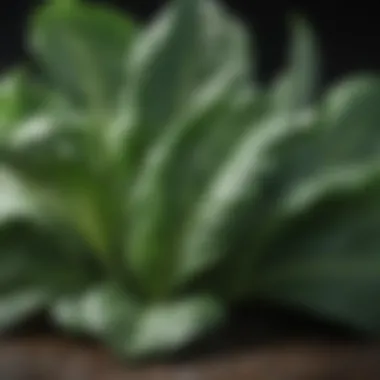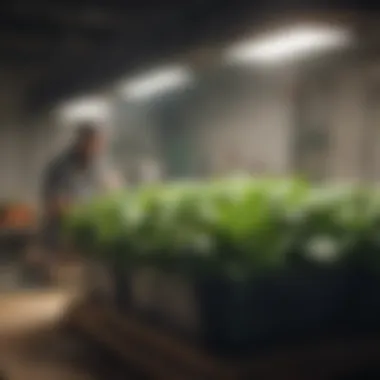Growing Spinach Indoors: Tips for Year-Round Harvests


Intro
Growing spinach indoors presents a unique opportunity for those who enjoy gardening yet face space limitations or unfavorable climate conditions. Spinach is celebrated not only for its versatility in cooking but also for its impressive nutritional profile. Cultivating this leafy green indoors allows year-round access to fresh produce, making it a rewarding venture for both novice and experienced gardeners.
This guide outlines essential factors that contribute to successful indoor spinach cultivation. It covers lighting requirements, soil composition, temperature control, and overall care. A thorough understanding of these elements can significantly enhance the growth potential of spinach, reducing common issues faced by indoor growers. Additionally, this guide highlights various spinach variants and offers insight into pest management as well as harvesting techniques to maximize your yield.
Through a careful exploration of each of these aspects, we aim to equip you with the knowledge needed to turn your indoor gardening space into a flourishing spinach patch.
Understanding Spinach
Understanding Spinach is a crucial aspect of the cultivation process. It establishes a foundation that can lead to successful growth and optimal yields. Spinach is not just a leafy green; it represents a convergence of both culinary versatility and significant health benefits. By grasping the nutritional advantages, common varieties, and cultivation requirements, individuals can make informed decisions about their indoor gardening endeavors.
Spinach has become increasingly popular for indoor gardening due to its rapid growth and adaptability to various conditions. This understanding aids those who seek to grow this vegetable in optimizing their approaches right from the beginning.
Nutritional Advantages
Spinach is rich in nutrients, making it a valuable addition to the diet. High in vitamins A, C, and K, it also provides essential minerals such as iron and calcium. The presence of antioxidants in spinach promotes good health by combating oxidative stress. Regular consumption of spinach can support heart health, improve bone density, and enhance skin health. Furthermore, its low-calorie count makes it an excellent choice for weight management.
Common Varieties of Spinach
Understanding the varieties of spinach can greatly influence success in indoor gardening. Each variety comes with its own characteristics, affecting the plant’s growth rate, flavor, and culinary use. The three primary types include Flat-leaved Spinach, Curly-leaved Spinach, and Noble Spinach.
Flat-leaved Spinach
Flat-leaved Spinach, often favored for its smooth texture, is easy to clean and cook. It has a mild flavor that lends itself well to various dishes, such as salads and smoothies. The flat leaves also allow for efficient packing and storage. This variety is a beneficial choice for indoor gardens as it grows quickly and produces ample leaves. However, it may require more care regarding potential pests, which can be a slight drawback.
Curly-leaved Spinach
Curly-leaved Spinach is recognized for its attractive, ruffled leaves. This variety is slightly sturdier than its flat-leaved counterpart, making it more resilient to environmental stressors. The unique texture adds an interesting element to dishes, enhancing both visual appeal and flavor. Its robustness can be particularly advantageous for beginners. While it is a popular choice among gardeners, the curly leaves can collect dirt and moisture, necessitating thorough washing before use.
Noble Spinach
Noble Spinach has been cultivated for centuries, known for its lush, dark green leaves. This variety tends to produce a higher yield, making it a favored option for those looking to maximize their harvest. Its flavor is slightly more robust than other types, appealing to culinary enthusiasts. The distinguishing feature of Noble Spinach is its ability to thrive in varying conditions, making it suitable for indoor growth. However, it may not grow as quickly as Flat-leaved Spinach, which could be a consideration for growers seeking faster results.
Preparing for Indoor Cultivation
Preparing for indoor cultivation of spinach is a fundamental step in ensuring a successful gardening experience. Understanding this phase sets the groundwork for effectively growing spinach indoors, allowing for optimal yield and quality. The right preparations can minimize challenges and enhance the growth environment.
Choosing the Right Space
The location where spinach is grown indoors is crucial. It should ideally receive ample natural light, but if that is not possible, artificial light becomes necessary. A space with good airflow is also important to prevent mold and mildew, which can adversely affect plant health. Additionally, the area should maintain a consistent temperature, ideally between 60 and 70 degrees Fahrenheit.
Essential Equipment and Supplies
Planting Containers
Selecting the right planting container influences the growth of spinach significantly. A key characteristic to consider is the depth of the container. Spinach has a relatively shallow root system; therefore, containers that are about 6 to 8 inches deep are generally ideal. Popular choices include plastic pots, which are lightweight and come with drainage holes to prevent overwatering. However, materials like ceramic offer better insulation. One disadvantage is that heavier materials may be less maneuverable. Therefore, one must weigh convenience against durability while choosing planting containers.
Soil Requirements
The right soil is essential for providing the nutrients spinach needs to thrive. A key aspect is that the soil must be well-draining to avoid waterlogged roots. A mixture of potting soil and compost is usually effective. This combination ensures adequate nutrients while maintaining proper drainage. Specialty potting mixes, such as those designed for vegetables, are also a good option. A unique aspect is that using organic matter can enhance soil fertility over time. However, reliance solely on low-quality soil can lead to poor growth and nutrient deficiencies.
Grow Lights


Grow lights are a vital component for successful indoor spinach cultivation, especially in areas with limited natural light. A primary characteristic of grow lights is their spectrum of light, which can affect photosynthesis. Full-spectrum LED grow lights are beneficial as they mimic sunlight and can be adjusted for height as spinach grows. This adaptability is a significant advantage since spinach thrives on consistency in light exposure. However, some lights can generate heat, necessitating careful placement to prevent overheating of plants.
The effective combination of the right space, planting containers, soil, and grow lights can greatly enhance indoor spinach cultivation, providing fresh greens regardless of climate.
Optimal Growing Conditions
Cultivating spinach indoors requires keen attention to optimal growing conditions. These conditions are not just about growing plant but also about sustaining their health and maximizing yield. Spinach thrives when its environmental needs are met, and this section discusses the crucial aspects of lighting, temperature, humidity, and watering.
Lighting Needs for Spinach
Spinach is a phototropic plant, meaning it responds positively to light. The right lighting impacts photosynthesis and, subsequently, the growth rate. For indoor growing, supplemental lights are often necessary, especially during shorter days of the year.
- Type of Light: Full-spectrum LED lights are ideal since they emit light that mimics natural sunlight. Fluorescent lights can also be used, particularly cool white lamps.
- Duration: Spinach generally requires about 12 to 14 hours of light each day to grow well. A light timer can help you maintain consistency.
Position the lights several inches above the plants to prevent burning while ensuring sufficient light reaches the leaves. Rotate the light source if you notice uneven growth.
Temperature and Humidity Considerations
Temperature control is vital for spinach. It prefers cooler environments, ideally between 60°F to 70°F (15°C to 21°C). High temperatures can cause bolting, meaning the plant flowers prematurely, which affects leaf quality.
Generally, maintain a steady temperature, avoiding drastic fluctuations.
- Humidity: Spinach also prefers higher humidity levels, around 40% to 60%. Dry air can lead to wilting or stress. To achieve this humidity, consider using a humidifier or placing water trays near your plants.
"Maintaining proper humidity levels can significantly reduce the risk of pests and diseases."
Watering Guidelines
Watering spinach correctly is fundamental to its growth. The soil must be kept consistently moist but not soggy. Over-watering can lead to root rot, a common problem with indoor cultivation.
- Frequency: Generally, water when the top inch of soil feels dry to the touch.
- Amount: Ensure deep watering, allowing the water to soak through the soil. This encourages deep root growth.
Also, consider the quality of water. Tap water may contain chemicals like chlorine, which can be harmful in high amounts. Using filtered water or letting tap water sit out for 24 hours can help.
Adhering to these optimal growing conditions will put you on the path to successful indoor spinach cultivation. Consistent care in lighting, temperature, humidity, and watering ensures robust plants that yield fresh, nourishing greens all year.
Planting Spinach Indoors
Planting spinach indoors is a critical phase of the growing process. It sets the foundation for a successful crop, ensuring that the plants receive the right start in a controlled environment. This stage includes selecting the right timing for sowing seeds, understanding the depth and spacing required, and preparing for the transplanting of seedlings. Each of these elements not only influences the health and yield of the spinach but also determines the overall success for indoor gardeners.
Sowing Seeds
Timing for Planting
Timing for planting spinach is essential for optimal growth. Spinach thrives in cooler temperatures, and the ideal time for sowing seeds indoors is generally late winter or early spring. During this period, indoor conditions can mimic the natural environment spinach prefers. The key characteristic of this timing is its alignment with the plant's growth cycle. By starting spinach indoors at the right moment, gardeners can avoid the heat of summer, which can lead to bolting, or premature flowering.
A unique feature of this timing is that it allows for successive sowing every few weeks. This continues to provide fresh spinach throughout the growing season. However, if not timed correctly, the disadvantage may include weaker plants that become overly stressed from heat.
Seed Depth and Spacing
Seed depth and spacing significantly impact the success of your indoor spinach cultivation. Generally, it is recommended to plant spinach seeds about half an inch deep. This depth provides sufficient protection while allowing adequate moisture to penetrate the seed coating. Another key characteristic is spacing; placing seeds around two inches apart ensures that spinaches have ample room to grow without competing too much for nutrients.
The advantage of proper seed depth and spacing is healthy plant development, leading to higher yields. Poor depth or cramped spacing could result in poor germination rates, leading to sparse crops.
Transplanting Seedlings


Transplanting seedlings needs careful attention. Once the seedlings have developed at least two true leaves, they should be transplanted into larger containers or into the final growing space. This step is important because it allows the plants room to expand their root system and access nutrients more effectively. Furthermore, transplanting too early can lead to stunted growth, while waiting too long may lead to root binding within the container.
In summary, planting spinach indoors involves precise timing, correct seed depth, and appropriate spacing. This foundation is critical for achieving a bountiful harvest. By understanding these aspects, gardeners can greatly improve their spinach growing experience.
Caring for Indoor Spinach
Caring for indoor spinach is essential for achieving a healthy and productive growth cycle. Unlike outdoor gardening, indoor environments present unique challenges and opportunities. Providing the right care ensures that the spinach thrives, which is significant for flavour, texture, and nutritional value. Healthy plants yield more and resist pests and diseases better. The focus should encompass fertilizer practices and pest management strategies to sustain optimal growth.
Fertilization Practices
Types of Fertilizers
Fertilization is crucial to replenish the soil nutrients that spinach requires over its growth cycle. There are generally two types of fertilizers: synthetic and organic. Synthetic fertilizers, such as Miracle-Gro All Purpose Water Soluble Plant Food, have a fast-acting nature that provides immediate nutrient availability. They are a popular choice among many indoor gardeners due to their ease of use. However, they often lead to nutrient leaching and can alter soil pH over time.
Organic fertilizers, on the other hand, include options like fish emulsion, compost, or worm castings. They release nutrients more slowly, promoting long-term soil health. The key benefit of organic fertilizers is their ability to improve soil structure while adding beneficial microorganisms. This can be advantageous, particularly in indoor setups that may lack biological diversity.
Application Frequency
Determining the right application frequency for fertilizers is essential. For most indoor spinach-growing setups, a bi-weekly application of water-soluble fertilizer during peak growing seasons is advisable. This ensures that the spinach has an adequate supply of nutrients as it grows. The unique aspect of regular applications is that it supports the continual uptake of essential minerals needed for robust growth.
However, one must be cautious not to over-fertilize. This can lead to nutrient burn, which damages the plants. In contrast, too little fertilization can result in weak and slow growth. Therefore, monitoring the plants' response to fertilization helps in refining the frequency to get the best results.
Pest Management Strategies
Common Pests to Watch For
Pests can pose a significant threat to indoor spinach. The most common culprits include aphids, spider mites, and whiteflies. These pests not only diminish the plants’ vitality but can also spread diseases. Identifying these pests early is important to mitigate damage.
Aphids are small and often cluster on the undersides of leaves. Spider mites may cause discoloration of leaves and webbing. Whiteflies typically settle on the underside of leaves and can be seen when disturbed.
Understanding these pests and their behaviours ensures that preventive strategies can be employed. Keeping a regular check on your spinach, inspecting both sides of the leaves, and maintaining cleanliness in the growing area contributes to low pest populations.
Natural Remedies
Using natural remedies helps manage pests effectively without relying on synthetic pesticides that can harm beneficial insects. Some popular natural remedies include neem oil, insecticidal soap, and diatomaceous earth.
Neem oil disrupts the life cycle of pests, while insecticidal soap creates a barrier that helps suffocate soft-bodied insects. Diatomaceous earth is a powder that damages the exoskeleton of insects leading to dehydration.
These remedies are advantageous for several reasons. They are usually less harmful to beneficial insects and contribute to an eco-friendly gardening practice. However, consistent application might be necessary, as natural remedies generally take longer to show results compared to chemical options.
"Indoor gardening requires attention and adaptation. With the right care, spinach can be a fruitful endeavour year-round."
In summary, caring for indoor spinach is a multifaceted task encompassing fertilization and pest management. Understanding the specific types and application frequency of fertilizers ensures robust growth, while awareness regarding common pests and natural remedies helps maintain healthy plants. By integrating these strategies, an indoor gardener can enjoy a thriving spinach crop.
Harvesting Spinach
Harvesting spinach is a crucial stage in indoor gardening. It signifies the culmination of efforts put into cultivation. Properly timed harvesting not only enhances the flavor of the spinach but also promotes further growth. Spinach is a fast-growing leafy green, and understanding when and how to harvest can lead to a continuous supply of fresh greens. This section aims to guide you through the optimal time for harvesting spinach, as well as techniques that ensure the integrity of the plant is maintained.
When to Harvest
Timing plays a significant role in harvesting spinach. Generally, spinach is ready to harvest when the leaves have reached a minimum length of three to four inches. This usually occurs about six to eight weeks after planting. Although spinach can be harvested at any stage, the best flavor and tenderness are achieved during this growth period.
Additionally, spinach can be harvested in two main ways: cut-and-come-again or one-time harvest. The cut-and-come-again technique involves trimming the outer leaves while allowing the inner leaves to continue growing. This method can extend the harvest period. Conversely, a one-time harvest fully removes the plant. Vegetables harvested using this first method often have a better taste, as they are cut at their peak freshness.
Observe your plants regularly, especially about a week before you plan to harvest. If the leaves look healthy and vibrant, it is likely the right time.
Harvesting Techniques
Cutting vs. Pulling


The choice between cutting and pulling spinach directly affects the plant's future growth and overall yield. Cutting spinach involves using a sharp knife or scissors to snip the leaves at the base. This method is highly recommended as it minimizes stress on the plant and encourages further growth. When cutting, select the outer most leaves first, allowing the inner leaves to mature.
On the other hand, pulling involves uprooting the entire plant, which can shock the remaining spinach and slow down future growth. While both methods yield quick results, cutting stands out due to its sustainability and potential for multiple harvests.
Avoiding Plant Stress
Avoiding plant stress during the harvesting process is essential. Stress can arise from abrupt removal of leaves or improper technique. When the plant is stressed, it may produce bitter flavors and slow down growth. By employing careful harvesting methods, you can maintain the plant's overall health.
Techniques such as gentle handling and ensuring that you leave some leaves on the plant contribute to reducing stress. A healthy plant is not only more productive but also offers a better flavor profile. Thus, selecting the right method helps keep your spinach thriving.
Key Takeaway: Choosing the right harvesting technique is vital for spinach longevity and flavor. By understanding the process and techniques, you can enjoy fresh spinach well beyond the initial harvest.
Common Challenges in Indoor Spinach Cultivation
Growing spinach indoors can be rewarding, yet it comes with several challenges. Understanding these obstacles is crucial for any enthusiast aiming for successful cultivation. Addressing common issues ensures healthy growth and a bountiful harvest, making it essential for indoor gardeners to prepare for these potential setbacks.
This section explores two primary challenges: issues with plant growth and environmental fluctuations. Grasping the nuances of these aspects is vital in developing effective strategies to mitigate problems and optimize spinach growth.
Issues with Growth
Growth issues are common when planting spinach indoors. Two of the main factors affecting growth include slow growth and disease prevention.
Slow Growth Factors
Slow growth can occur for various reasons. Factors like inadequate lighting, inappropriate temperature, and insufficient nutrients contribute significantly to this issue. Spinach tends to be sensitive to its environment.
For example, insufficient light slows photosynthesis. Furthermore, inadequate watering can lead to weaker plants. If spinach does not get sufficient nutrients, the growth will stagnate. These factors make it essential to monitor conditions closely.
On the positive side, identifying slow growth factors can lead to adjustments that foster vigorous growth. It encourages a more proactive approach to indoor gardening, leading to a better understanding of plant needs.
Disease Prevention
Disease prevention plays a crucial role in indoor spinach cultivation. Many common diseases can threaten spinach, including downy mildew and root rot. These ailments not only hinder growth but may also ruin entire crops.
Maintaining proper humidity levels and ensuring that air circulates well can significantly reduce the risk of diseases. Regular inspection of leaves and stems is vital, as early detection can make treatment easier.
This emphasis on disease prevention provides several benefits. It promotes a healthier indoor garden and ultimately enhances the quality of the spinach harvested.
Environmental Fluctuations
Environmental fluctuations present another challenge in growing spinach indoors. Indoor spaces may have varying light levels and temperature changes throughout the day. This inconsistency affects the overall health of the plants.
Creating a stable environment is fundamental. This could mean relocating plants to adjust for light intensity or insuring that the temperature remains steady. Investing in devices like thermostats can help regulate warmth, while grow lights can maintain light levels.
The End
The conclusion serves as a vital component of this article, reinforcing the significance of understanding indoor spinach cultivation. Growing spinach indoors not only provides fresh greens with tremendous nutritional benefits, but it also caters to the ever-increasing interest in sustainable living. By summarizing the key considerations and practices throughout the guide, readers can appreciate the carefully curated details necessary for successful indoor gardening.
Recap of Key Points
In this article, we have focused on several pivotal aspects of growing spinach indoors:
- Nutritional Advantages: Spinach is rich in vitamins A, C, and K, iron, and antioxidants, making it an excellent addition to any diet.
- Optimal Growing Conditions: Understanding the right light, temperature, and watering conditions is crucial for healthy growth. Spinach prefers cooler environments and requires adequate light for photosynthesis.
- Planting Techniques: Proper sowing of seeds at the correct depth and spacing is fundamental to healthy growth. Regular monitoring and careful transplanting further promote vitality.
- Caring for Spinach: Fertilization and pest management strategies are essential practices. Using natural remedies can help maintain the plant's health while minimizing chemicals in your gardening space.
- Harvesting Methods: Knowing when and how to harvest spinach can maximize yield. Techniques such as cutting rather than pulling help maintain plant integrity.
Future Considerations for Indoor Gardening
As indoor gardening continues to gain popularity, aspiring gardeners should keep several factors in mind:
- Adapting to Climate Change: Indoor gardening allows for year-round growth, which is essential given current climate shifts. Homeowners can adjust their practices according to unpredictable weather patterns.
- Expanding Plant Variety: Diversifying indoor crops can increase not only enjoyment but also the overall yield. Experimenting with herbs and different greens can lead to a more fulfilling gardening experience.
- Investing in Technology: Utilizing smart gardening technologies can enhance indoor growing conditions. Automated watering and grow-light systems help ensure optimal plant health with minimal effort.
- Building Community: Sharing insights and experiences through platforms like Reddit or gardening groups on Facebook can lead to a richer understanding of indoor gardening. Networking provides a valuable resource for troubleshooting common challenges and celebrating successes.
Overall, the journey of growing spinach indoors is fulfilling and educational. By applying the knowledge gained from this article, readers are now better equipped to embark on their indoor gardening ventures.



